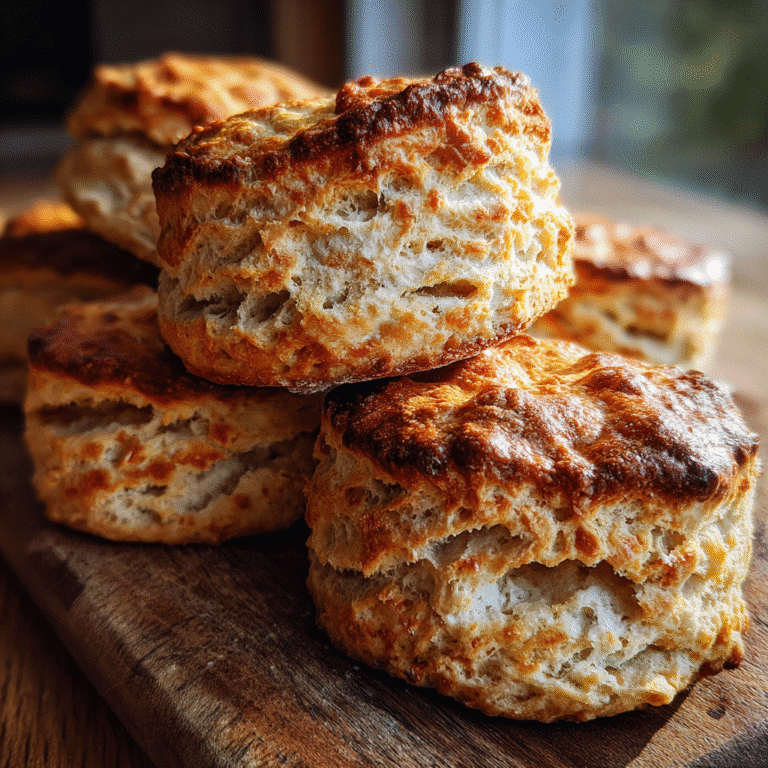Sourdough discard biscuits are a delicious way to give your leftover sourdough starter a second life. Instead of tossing that valuable discard, why not transform it into something warm, buttery, and satisfying? These biscuits not only prevent waste but also deliver deep flavor, flaky layers, and a rustic charm that makes them perfect for breakfast or dinner sides.
In this guide, you’ll learn exactly how to make the best sourdough discard biscuits, why they’re worth the effort, and how to store and serve them. We’ll also share expert baking tips, creative discard ideas, and surprising health benefits. Whether you’re new to sourdough baking or a seasoned starter keeper, these biscuits are a must-try.
Discover great ideas like this cloud bread breakfast twist.
Table of Contents
Why Use Sourdough Discard in Biscuits?
Understanding Sourdough Discard and Its Flavor Benefits
Sourdough discard biscuits are more than just a baking trend—they’re a smart, flavorful way to avoid wasting your starter. Every time you feed your sourdough, you’re left with discard, which contains all the fermented richness of the starter without the leavening power. That discard may not rise bread, but it’s perfect for baking biscuits.
The tangy edge of sourdough discard enhances biscuit flavor, giving you a more complex taste compared to plain baking powder biscuits. This flavor pairs beautifully with butter and makes your biscuits stand out from the average batch. Plus, using discard makes your baking process more sustainable and budget-friendly.
Not to mention, sourdough discard biscuits can develop a tender texture thanks to the added hydration and acidity from the discard. You’ll find that even a small amount can make a big impact on the final result.
Is It Safe to Use Old Sourdough Discard in Recipes?
Many bakers wonder if old sourdough discard is still usable, especially when making sourdough discard biscuits. The answer is yes—discard stored in the fridge for up to a week is usually safe, as long as it shows no signs of spoilage.
Here’s what to check:
- It should smell tangy, not foul or rotten
- It shouldn’t have pink, orange, or green discoloration
- Mold = toss it out
If your discard passes the test, you’re good to go. In fact, slightly older discard can offer a more pronounced flavor, which works well in recipes like sourdough discard biscuits that benefit from an extra kick.
Check out this creative cookie-in-a-pan idea.
Print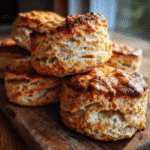
Sourdough Discard Biscuits: The Best Ways to Bake with Your Leftover Starter
- Total Time: 30 minutes
- Yield: 8 biscuits
Description
Flaky, buttery, and rich with tangy flavor—these sourdough discard biscuits are the ultimate way to use up leftover starter and elevate your breakfast or dinner sides.
Ingredients
- 2 cups all-purpose flour
- 1 tbsp baking powder
- 1 tsp salt
- 1/2 cup cold butter (1 stick)
- 1 cup sourdough discard
- 1/2 cup milk or buttermilk
Instructions
- Preheat oven to 425°F (218°C) and prepare a baking sheet with parchment paper or grease.
- Whisk together flour, baking powder, and salt in a large bowl.
- Cut in cold butter using a pastry cutter or fingers until mixture resembles coarse crumbs.
- Stir in sourdough discard and milk just until a soft dough forms—do not overmix.
- Turn dough onto a floured surface, fold 4–5 times, press to 1-inch thickness, and cut into shapes.
- Place on baking sheet; for crisp edges, space apart; for softer sides, let biscuits touch.
- Bake 12–15 minutes until tops are golden brown.
- Brush tops with melted butter after baking. Serve warm.
Notes
Use discard that’s no older than a week and shows no signs of spoilage. Cold butter and gentle folding create the best flaky layers.
- Prep Time: 15 minutes
- Cook Time: 15 minutes
- Category: Baking
- Method: Baking
- Cuisine: American
How to Make Fluffy Sourdough Discard Biscuits
Essential Ingredients You Need
Making sourdough discard biscuits starts with a short list of pantry staples. The magic happens when these simple ingredients are combined with sourdough discard to create a biscuit that’s fluffy, flavorful, and slightly tangy. Here’s what you’ll need:
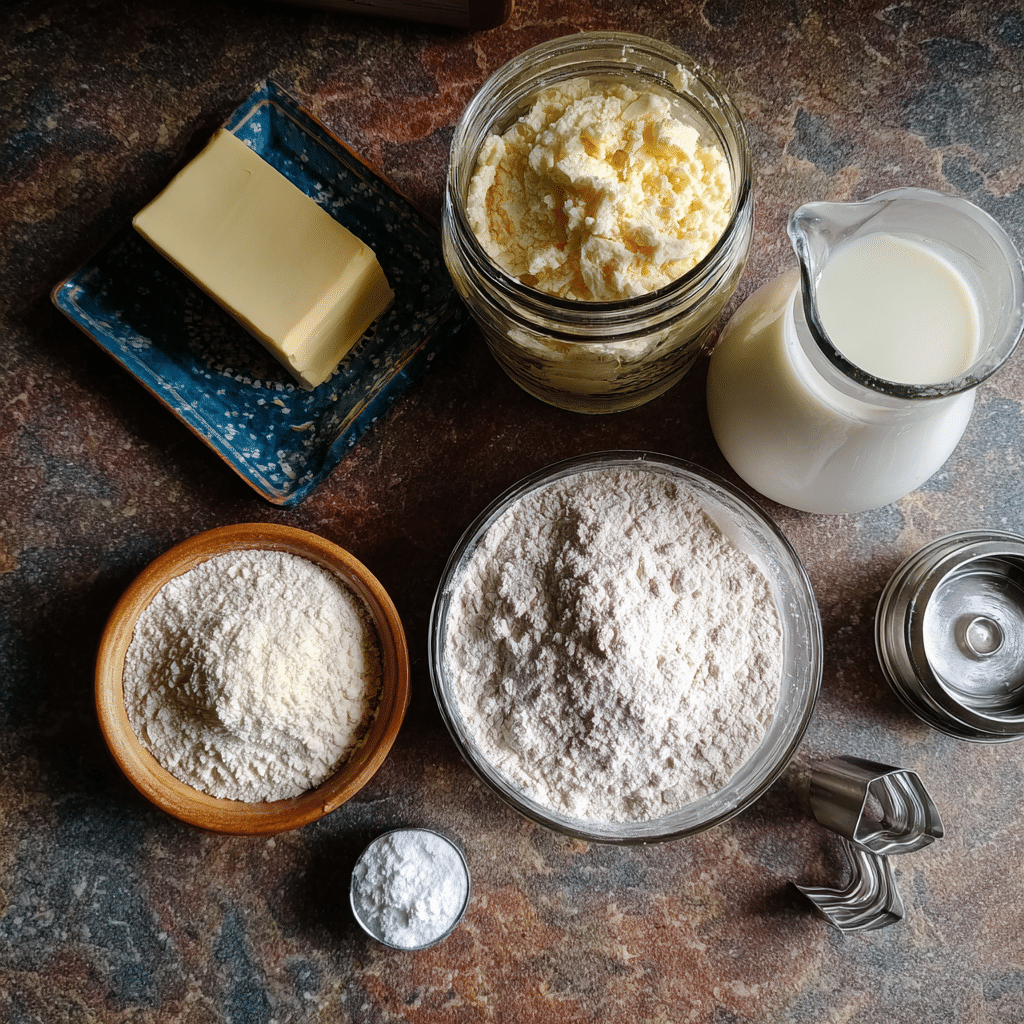
| Ingredient | Quantity | Purpose |
|---|---|---|
| All-purpose flour | 2 cups | Structure and base |
| Baking powder | 1 tbsp | Rise and lift |
| Salt | 1 tsp | Enhances overall flavor |
| Cold butter | 1/2 cup (1 stick) | Flaky layers and richness |
| Sourdough discard | 1 cup | Adds moisture and tang |
| Milk (or buttermilk) | 1/2 cup | Helps form a soft dough |
For extra depth, some bakers mix in shredded cheese, garlic powder, or fresh herbs. But even plain, sourdough discard biscuits have enough flavor to hold their own.
Pro Tip: Always use cold butter. When butter melts in the oven rather than during mixing, you get those iconic layers every biscuit lover craves.
Step-by-Step Instructions for Perfect Texture
Let’s walk through how to make perfectly soft, flaky sourdough discard biscuits that rise high and taste amazing.
Step 1: Preheat and Prep
Preheat your oven to 425°F (218°C). Line a baking sheet with parchment paper or lightly grease it. This high temp helps the biscuits rise fast and develop golden tops.
Step 2: Mix the Dry Ingredients
In a large bowl, whisk together the flour, baking powder, and salt. These dry ingredients form the foundation for fluffy biscuits.
Step 3: Cut in the Cold Butter
Use a pastry cutter or your fingertips to cut the butter into the flour mixture until it resembles coarse crumbs. This step is essential to creating that tender, flaky texture.
Step 4: Add Sourdough Discard and Milk
Stir in the sourdough discard and milk until a soft dough forms. Avoid overmixing, which can make your biscuits tough.
Step 5: Fold and Shape the Dough
Turn the dough onto a floured surface and fold it over itself 4–5 times. This step creates layers. Gently press it to 1-inch thickness and cut into circles or squares.
Step 6: Bake to Perfection
Place the biscuits on your baking sheet and bake for 12–15 minutes until golden brown. If you want crisp edges, place them spaced apart. For soft sides, let them touch.
Step 7: Brush and Serve
Once baked, brush the tops with melted butter for extra flavor. Serve warm and enjoy.
Learn more about layering technique from this comforting recipe.
With the right ingredients and a little care, your sourdough discard biscuits will rival anything from a bakery. The sourdough adds that subtle complexity, while the method ensures they stay soft on the inside and lightly crisp on top.
Don’t miss our fun twist on cinnamon rolls .
Baking Tips for the Best Sourdough Biscuits
How Long Should You Bake Sourdough Discard Biscuits?
When it comes to baking sourdough discard biscuits, timing is key. Bake them too short, and they’ll be undercooked in the center. Too long, and you’ll lose that soft, fluffy texture that makes them irresistible.
The ideal baking time is 12–15 minutes at 425°F (218°C). The biscuits should rise beautifully and develop lightly golden tops. The actual time depends on the size and thickness of your dough rounds, as well as your oven’s accuracy.
To check for doneness, gently lift a biscuit—its bottom should be golden brown and crisp, while the top stays slightly soft to the touch.
Bonus Tip: If you’re making extra-large sourdough discard biscuits, extend baking to 16–18 minutes and tent the tops with foil halfway through to prevent overbrowning.
Check out our comforting soup pairing.
Common Mistakes and How to Avoid Them
Even seasoned bakers can run into issues when working with sourdough discard biscuits. Here are some of the most frequent slip-ups—and how to fix them.
1. Using warm butter
Warm butter blends too smoothly into the flour, eliminating those crucial butter chunks that create steam and layers. Always keep your butter cold and cubed before mixing.
2. Overmixing the dough
Mixing too long activates gluten, which can make biscuits dense and chewy. Stir just until the ingredients are combined.
3. Skipping the fold
Folding the dough 4–5 times helps create pockets of butter and adds height. Don’t skip this step if you want lofty, layered sourdough discard biscuits.
4. Crowding the pan incorrectly
If you want softer biscuits, place them close together so they steam one another. If you prefer crisp sides, leave space between each.
5. Not brushing with butter
Finishing your biscuits with a butter glaze after baking adds shine, richness, and flavor. You can even add a sprinkle of sea salt or herbs for extra flair.
By following these practical tips, you’ll bake sourdough discard biscuits that rise tall, stay moist, and deliver consistent results every time. Don’t let a little leftover starter go to waste—let it become your next crave-worthy creation.
Looking for a sweet finishing touch? Try this banana syrup recipe.
Creative Ways to Use Sourdough Discard in Baking
Other Delicious Recipes Besides Biscuits
While sourdough discard biscuits are a fan favorite, your discard’s potential doesn’t end there. In fact, sourdough discard is one of the most versatile ingredients in a baker’s kitchen. With its mild tang and natural hydration, it’s ideal for dozens of baked goods.
Here are some delicious ways to use up your discard:
- Sourdough Discard Pancakes: Light, fluffy, and packed with tangy flavor—perfect for weekend brunch.
- Crackers: Thin, crunchy, and loaded with herbs or cheese, these are the ultimate zero-waste snack.
- Sourdough Banana Bread: Moist, flavorful, and great for using overripe bananas and discard in one go.
- Pizza Dough: The fermentation helps the crust develop a deep, artisan-style flavor.
- Flatbreads: Quick to make and ideal for wraps or dips.
What makes all of these recipes shine? That signature sourdough flavor, developed over days in your starter and carried into your bake.
Don’t miss our unique take on sweet-and-savory tortillas.
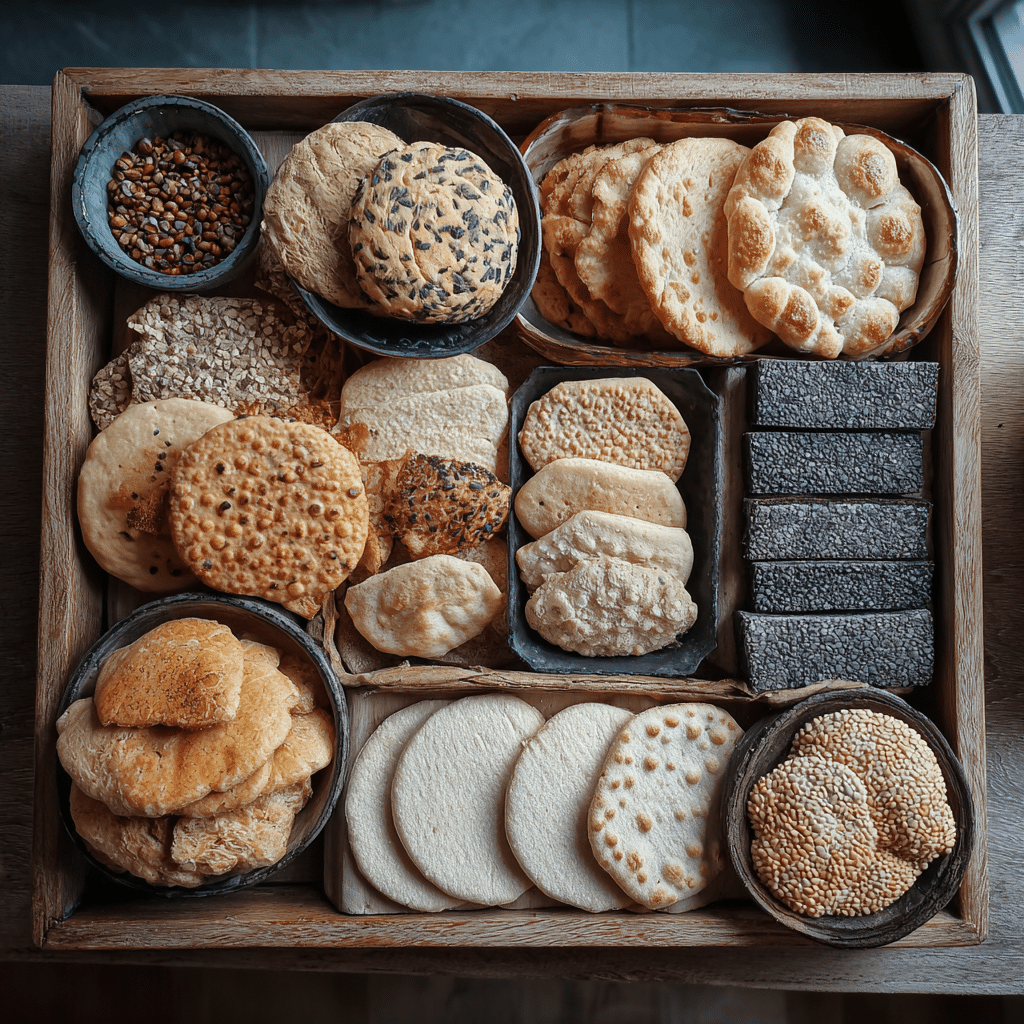
Transforming Discard into Snacks and Sweets
Not into baking full meals? You can still enjoy the benefits of sourdough discard in small, snack-sized portions or sweet bites. Try these ideas:
- Sourdough Chocolate Chip Cookies: A chewy twist on a classic recipe. The acidity balances the sweetness beautifully.
- Muffins with Discard: Whether blueberry, lemon poppyseed, or apple cinnamon, discard adds complexity and keeps them moist.
- Crumb Cakes and Coffee Cakes: The slightly tangy base makes a great match for sweet streusels and glazes.
- Crusty Griddle Cakes or Skillet Breads: Quick to fry and super satisfying.
And yes, you can experiment with sourdough discard biscuits in dessert form too. Add a little sugar, cinnamon, and drizzle with icing for a sweet biscuit perfect for breakfast or brunch.
Check out our chaos cakes inspiration for more baked twists.
By getting creative with your sourdough discard, you’re not only reducing waste but also adding new flavors and textures to your kitchen. While sourdough discard biscuits are an easy win, there’s a whole world of baking beyond them waiting for you to explore.
Health Benefits of Sourdough Discard Biscuits
Is Sourdough Discard Still Gut Healthy?
One of the biggest reasons sourdough baking has exploded in popularity is its gut health benefits. But what about sourdough discard biscuits? Do they retain those same perks?
The short answer is: yes, to some extent. While the discard used in biscuits is often unfed and may not be actively fermenting, it still carries live cultures and acids formed during the fermentation process. These organic acids and trace probiotics can contribute to digestive wellness.
Here’s how sourdough discard may support your gut:
- Lower Phytic Acid: Sourdough fermentation reduces phytic acid, which may improve mineral absorption.
- Easier on the Stomach: Many people find sourdough discard biscuits easier to digest than traditional biscuits because the flour has already started breaking down.
- Moderate Gluten Impact: While not gluten-free, the fermentation weakens gluten proteins, potentially reducing sensitivity in some individuals.
That said, the actual probiotic content will be lower than in raw sourdough or long-fermented bread. Still, for a comfort food like biscuits, it’s a health bonus you don’t normally expect.
Looking for gut-friendly beverage pairings? Try glow tea.
Nutritional Value Compared to Regular Biscuits
From a nutritional standpoint, sourdough discard biscuits stack up favorably against traditional biscuits. Here’s a quick comparison:
| Nutritional Element | Traditional Biscuits | Sourdough Discard Biscuits |
|---|---|---|
| Flavor Profile | Buttery, plain | Buttery with tangy depth |
| Fiber Content | Moderate | Slightly higher |
| Probiotic Potential | None | Low to moderate |
| Digestibility | Average | Easier to digest |
| Sugar/Carb Spike | Faster | Slower, due to acidity |
Adding sourdough discard not only enhances flavor but may slightly lower the glycemic response. The acids in the discard help slow down digestion of starches, which can reduce blood sugar spikes.
Of course, the healthiness also depends on the rest of your ingredients. Using whole wheat flour, plant-based milk, or grass-fed butter can level up the nutritional profile of your sourdough discard biscuits even more.
Learn more about incorporating wholesome ingredients in savory dishes
When made with quality ingredients, sourdough discard biscuits offer more than just comfort—they deliver subtle gut benefits, improved digestibility, and a more balanced nutrition profile than many store-bought options.
Storage, Serving, and Pairing Ideas
How to Store Sourdough Biscuits for Freshness
After baking a beautiful batch of sourdough discard biscuits, you’ll want to make sure they stay just as delicious the next day. Fortunately, these biscuits store well—if handled properly.
Here’s how to store them:
- Room Temperature: Place cooled biscuits in an airtight container and store for up to 2 days.
- Refrigeration: Wrap them in foil or place in a resealable bag for up to 5 days.
- Freezing: Freeze on a tray first, then store in a zip-top bag. They’ll last up to 3 months. Reheat in the oven at 350°F for 8–10 minutes for best texture.
Sourdough discard biscuits retain moisture better than regular biscuits due to the discard’s acidity, which helps prevent them from drying out quickly.
Pro Tip: Avoid storing in plastic without a paper towel lining—it can make biscuits soggy.
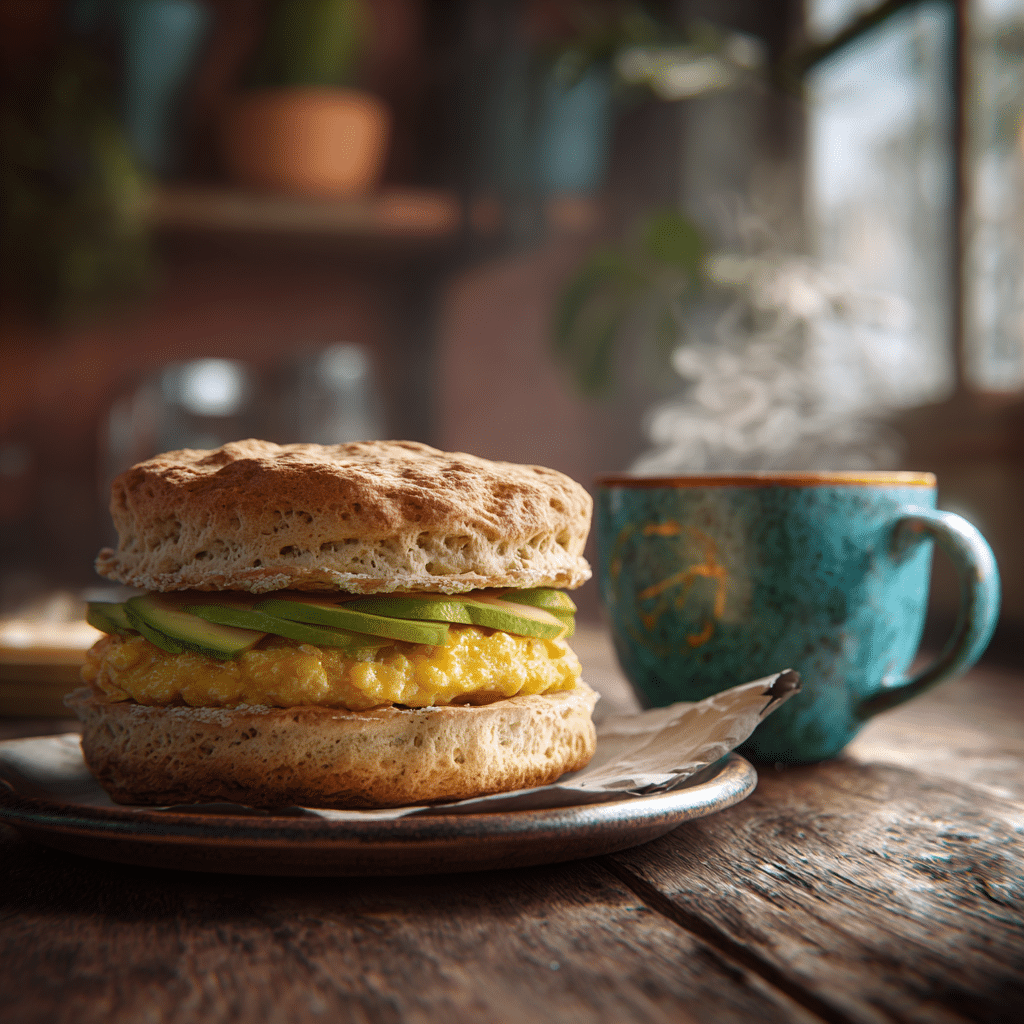
What to Serve with Sourdough Discard Biscuits
These flaky, tangy biscuits are super versatile. Whether sweet or savory, they hold up to bold flavors and simple pairings alike. Here are some tasty ways to serve them:
- For Breakfast: Add scrambled eggs, avocado, or sausage patties for a satisfying biscuit sandwich.
- For Brunch: Serve with honey butter, berry jam, or cinnamon spread.
- For Dinner: Use them as a base for biscuits and gravy, or pair with creamy soups and chili.
- For Snacks: Toast and top with cheese, leftover roast meats, or roasted veggies.
Want to turn them into dessert? Add a sprinkle of sugar and cinnamon before baking, then drizzle with glaze.
Don’t miss our cozy dinner favorite that pairs perfectly.
Whether you’re prepping a quick breakfast or building out a full Southern-style meal, sourdough discard biscuits are the ultimate crowd-pleaser. And when stored right, you can enjoy their soft, flaky goodness all week long.
Conclusion
If you’ve been throwing away your sourdough discard, now’s the time to stop. Sourdough discard biscuits are one of the most satisfying, flavorful, and resourceful ways to use up that leftover starter. With their golden tops, soft interiors, and rich tang, they’re more than just a side—they’re a standout on any plate.
From learning the right baking time and folding technique to storing leftovers and pairing with the perfect spread, we’ve covered everything you need to master these flaky, buttery gems. And the best part? You’re reducing waste while upgrading your kitchen skills.
So the next time your starter needs feeding, don’t toss the discard. Whip up a fresh batch of sourdough discard biscuits—your tastebuds (and your gut) will thank you.
Frequently Asked Questions About Sourdough Discard Biscuits
Can I just bake my sourdough discard?
Technically, you can bake sourdough discard on its own, but don’t expect it to turn into something fluffy or delicious. Without additional leavening like baking powder or soda, it won’t rise or form the texture we expect in baked goods. Instead, it’s best used in recipes like sourdough discard biscuits, pancakes, crackers, or muffins—where its acidity and moisture bring flavor and softness.
So, while you could pop it in the oven, you’ll get far better results when it’s part of a real recipe.
How long to bake sourdough biscuits?
For standard-sized sourdough discard biscuits, bake at 425°F for 12–15 minutes. You’re aiming for golden brown tops and fully cooked centers. Larger biscuits may need up to 18 minutes, but keep an eye on the bottom—if it’s browning too fast, lower the heat slightly.
Pro tip: placing biscuits close together on the tray results in softer sides, while spacing them out yields crispier edges.
Is sourdough discard still gut healthy?
Yes, sourdough discard retains some of the fermentation benefits of its active starter. It may contain organic acids, trace probiotics, and a lower phytic acid content, all of which support digestion. While baking kills most live cultures, the discard still contributes to a healthier baked good than many traditional options.
That’s part of what makes sourdough discard biscuits not just tasty—but a bit easier on the stomach too.
How do you use old sourdough discard?
Old sourdough discard—if it smells tangy and not spoiled—is ideal for a wide range of recipes. Beyond biscuits, it’s perfect for crackers, waffles, pizza dough, muffins, and quick breads. The longer it’s been stored (within reason), the more complex its flavor becomes.
To be safe, always check for mold or strange colors. But don’t toss good discard—transform it into something amazing, like buttery sourdough discard biscuits.

